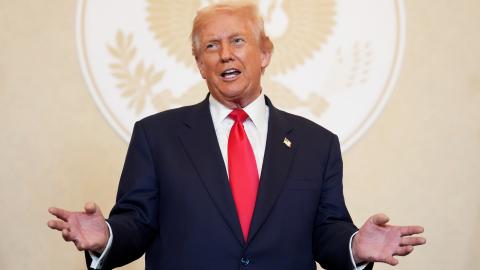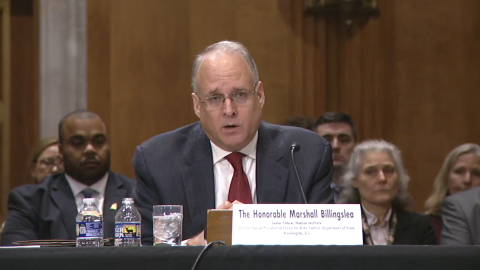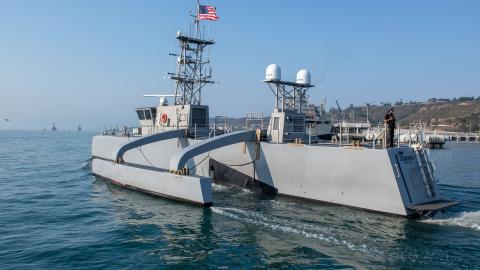Miles sits down with Tory Bruno, chief executive officer of United Launch Alliance, an organization dedicated to pioneering technologies that support humanitarian, national security, and commercial space-based initiatives. They discuss the importance of strategic space policy and security under the ever-evolving United States–China strategic competition dynamic; where the US stands in relation to Chinese satellite technology, development, and infrastructure; and what strategies the US and its allies should prioritize to counter China’s efforts to dominate the space domain.
China Insider is a weekly podcast project from Hudson Institute’s China Center, hosted by China Center Director and Senior Fellow, Dr. Miles Yu, who provides weekly news that mainstream American outlets often miss, as well as in-depth commentary and analysis on the China challenge and the free world’s future.
Episode Transcript
This transcription is automatically generated and edited lightly for accuracy. Please excuse any errors.
Miles Yu:
Welcome to China Insider, a podcast from the Hudson Institute’s China Center. I am Miles Yu, Senior Fellow and Director of the China Center. Join me each week for our analysis of the major events concerning China, China threats, and their implications to the US and beyond.
Welcome to China Insider Interviews, a podcast from the Hudson Institute’s China Center. I’m Miles Yu, Senior Fellow and Director of the China Center. In this segment of China Insider Interviews, I’m thrilled to welcome Tory Bruno, President and CEO of United Launch Alliance (ULA) to discuss the importance of space policy and security under the ever-evolving umbrella of US-China strategic competition. For our listeners, ULA is a premier space launch company focused on heavy class payloads and the most exotic orbits and [is] a mainstay of US national security establishment working to expand the commercialization of space. Let me introduce our guest of honor today.
Over the course of a 40-year career, Tory has developed and fielded dozens of advanced aerospace systems. He’s a rocket scientist with expertise in space rocketry, hypersonics, and the director energy capacities, holding multiple related patents. He also has considerable expertise in nuclear deterrence, missile defense and space launch programs. Tory is an American Institute of Aeronautics and Astronautics Honorary fellow, a member of the DOD Defense Innovation Board Space Advisory Committee, and the National Academy of Engineering, as well as serving as a member of the National Space Council Users Advisory Group. Tory is also an awardee of the Van Brown Trophy, a holder of the van Karman Medal, and a member of the space and satellites professionals and the San Diego Air and Space Museum International Halls of Fame. Tory, it’s a pleasure to have you on Insider Interviews and thank you for being here with us today.
Tory Bruno:
Oh, Miles, it’s my pleasure.
Miles Yu:
Let me - just for the benefit of our listeners - could you tell [us] a little bit about your company, United Launch Alliance, about its history and its mission?
Tory Bruno:
Yeah, I’d love to. So, ULA was formed back in 2006 primarily to support the United States government, both national security and NASA. At that time, there was sort of an emerging potential crisis in space where the national security assets that were on orbit were well past their design life. The replacements were really next generation technology, which was really, really cool, but also, they were technically challenged and really late and it was expected there would be gaps in coverage places without GPS, whether forecasting really degraded that kind of thing. ULA was stood up, to go support that need with the mission of failure [being] much less often that is traditional in the launch industry, because these assets are precious. And I know we told you, the government told you, what we were going to fly when, but hey, if something is late and something else is on time or early, whatever shows up to the launchpad, you get it to space. So that was sort of our background for probably about 10 years, ULA was the only domestic provider and that was the mission. Then the industry grew up a little bit, competition was possible and new people joined in. I came about that time to ULA to help move it from that sole source environment to one that still supported all those very exotic government missions, but in a competitive environment and moving technology in ahead to try and meet these new challenges the country is facing right now.
Miles Yu:
Great. So, the title of the company has the word “alliance” in it. “Alliance” implies [that] there’s members. So, what are the core members of this alliance?
Tory Bruno:
Right. ULA is owned by Boeing and Lockheed in a 50-50 share, and when the company was originally set up, it was part of a consolidation in order to make it more efficient. So, all of the people who worked on the Delta launch vehicle program at Boeing quit working for Boeing and were rehired by the new company ULA. The same thing happened over at Lockheed Martin, where all of the Atlas team resigned from Lockheed were rehired into ULA, the company inherited both of those rockets and started flying them. Today of course we have retired the Delta Rocket, we’re still flying out Atlas 13 to go, and we have developed a brand new rocket called Vulcan that takes on the job of both and replaces the Atlas’s venerable Russian RD-180 rocket engine that powered its first stage and was sort of a key element of international policy at a time. We didn’t want the Russian rocket scientists wandering off to North Korea, Iran looking for employment, but those days have passed. They really went away with the initial invasion of Crimea, and so we moved off of that platform as well.
Miles Yu:
That’s great. So, it’s often been said that one unique feature of the American system is that government and the private enterprises are separate, and in this case it’s a very good example of this kind of joint effort by a private company such as yours and the government mission. When we say “space program,” most countries are basically government run [in that] it’s a national space program. In this sense, I think there is this private entrepreneurship and private expertise, and you have a unique model of operation that space stresses on efficiency and innovation. Obviously today when we hear about this kind of government-private space cooperation, people talk about the SpaceX that’s under Elon Musk, but obviously ULA also occupies a very unique portion of that. How do you compare your company and SpaceX for example?
Tory Bruno:
Yeah, that’s a great question and your lead into that is so true. That is the great power of our system, that we are able to have these private companies with their innovation and entrepreneurship work in partnership with the government to support their needs. We are of course SpaceX’s primary competitor in this heavy lift marketplace. We both support the United States government and NASA. SpaceX has opened the market up into this so-called low latency, high speed internet in low earth orbit with their Starlink constellation and we are now populating its primary competitor, Amazon’s Kuiper. So, that’s really splitting that marketplace and providing competition which drives investment and innovation. In terms of the respective places you occupy, because you never want, even in a competitive environment, sort of two carbon copy services that are not differentiated in any way because when you have that, it’s not the most healthy market environment.
You end up just two companies that copy everything each other does. They drive costs down, which feels good at first, but over time they stop investing in technology, and then eventually you have this race to the bottom and you end up with less choices or less capabilities for the government. That’s not what we have here. This is a very healthy environment. SpaceX specializes in rockets that are optimized to deliver their payloads at low earth orbit (LEO), as is the other new players in our marketplace. Blue Origin with its New Glenn that is just about to start servicing customers and even Aireon in Europe. So, the spacecraft itself might go beyond LEO, but the rocket is done in LEO, and that dictates a certain design and architecture of the rocket. We, on the other hand, specialize in these exotic, primarily government orbits, and so our new rocket Vulcan is really designed with that in mind.
So we stage, for example, the first stage, we burn that out at a much, much higher altitude and velocity all the way into space so that our upper stage is dropped off still full of propellant so that it can fly beyond LEO all the way out to say a direct injection into a geosynchronous orbit. We’re 12 hours later instead of half an hour later, we then drop off that spacecraft. And so, we both have overlap in both spaces, but we’re kind of optimized in one place or another, which is kind of the healthiest form of competition.
Miles Yu:
That’s an excellent, excellent explanation. And from what I’ve known, it is the space assets we have at a much higher altitude that really form the crown jewel of the US defense system. So Tory, let me ask you another question. What are some of the key programs or technologies ULA is currently working on that contributes to US national security and the resilience in the space domain? Now of course, this is only relevant to the area of knowledge that you could share in public.
Tory Bruno:
Yes, of course. Yeah, we’ll keep this all very unclassified because I don’t look all that great in orange, so we’ll restrict our comments there. The things that we are able to do and really sort of invest capabilities in at ULA involve orbits that obfuscate what the payload is and that destination is to make the job of an adversary, say China for example, who are fielding in space anti-satellite weapons that much more difficult. And we’re doing a lot of investment right now in both extending the endurance of this very powerful, very fast high energy upper stage so that it can maneuver through space much more robustly after it’s been deployed and potentially even do missions that aren’t done today like relocation of satellites or the servicing of satellites and god forbid, interfering with attacks and space as they’re developing. So, that’s been a major thrust for us.
At the same time, we are developing reusability technologies in order to help facilitate an even higher launch rate. Those also help with the expense of the launch system, but really you also see an immediate impact on your ability to turn vehicles. Now, our kind of reusability is different than flying boosters back like SpaceX does, because of the architecture of the rocket flying twice as high, three times as fast, ten times as down range, means you can’t really save propellant and fly home with it. You have to use a different technique like dropping off engines and recovering them, that sort of thing. And even that is a very unique set of technologies that wasn’t possible 10 years ago but is now.
Miles Yu:
That’s a very good answer, thank you very much once again. Now in our earlier conversation we talk about [how] you also would like to commercialize your space program. When you say commercialization, that probably means a lot of LEO and geo-synchronization assets like what SpaceX is doing. My sense is that since you do the heavy payloads and the extremely high altitude launches, would you say that your customer in a commercial sense it would be the government?
Tory Bruno:
No, actually, in this case our LEO commercialization is in fact Amazon. And what we’ve had to do is do some clever systems engineering to make that high energy orbit injection rocket competitive down in that marketplace. One of the, sort of, rules when you develop a launch vehicle is you pick your orbit you want to be most efficient at, you can do others, but you’re most efficient at that one, design it around it and then you’re stuck with it. You have the rocket you built; satellites get bigger, smaller, they go higher and lower, but there you are. And so, we cheat that rule a little bit. We have a basic liquid-fueled rocket like everybody else has, but then we can add to it solid rocket motors literally bolted on zero, two, four, six. We also have different versions of the upper stage and what that does is it really flattens out levels out in a way the performance curve over the orbits.
So, when you look at a LEO optimized rocket at a purely O rocket, it does a great job at low earth orbit in terms of not just its affordability, but its mass. It can deliver there, but then as you go to these higher orbits, it falls off pretty abruptly. And then, the high energy orbit rocket would do the opposite. But by using this technique, it’s as if we have four different first stages and two different upper stages, and what it does is it flattens it all out so that we can reach down into that LEO orbit space and do a good job for Amazon on their Kuiper systems as well. But, having said that, again, the beauty of this type of capital marketplace is that you’re always in competition, so you have to keep investing in your technology and improving your product and making it more versatile, which now that we’re flying Vulcan we’ll continue to do
Miles Yu:
So. From what you just said, I assume that Amazon is a part of your alliance as well?
Tory Bruno:
Amazon is our primary commercial customer.
Miles Yu:
Oh, I see. Okay. Yeah, I got it. Now, let me switch the gear a little bit to a different direction. Now we all know that US-China [relations] now is locked in what the United States calls “strategic competition.” China has a different term for that, and in China’s case it’s a life and death struggle. That’s much more serious. Now, I remember that in 2019 in the spirit of commemorating the 50th anniversary of the moon landing by the United States, IPSOS and the CSPAN conducted a joint public opinion poll. The question was, “would you still support the United States to resume the moon landing program?”
The people who were polled responded very lukewarm. Only 11% said yes, and most of them said, this is a waste of money. The same question was asked, but add one proviso, that is, would you just support US government spending money to resume the moon landing if China is trying to get land on the moon, ahead of us. The answer (yes answer) went up to 49% immediately. So, that means the nation is on course with what the national consensus said, [which is] that China is our leading national security threat even particularly in space. Tory, can you outline the current state of US-China’s strategic competition in the space domain, particularly regarding satellite technology and infrastructure. In particular, in your assessment, what are the key advancements China has made in this space capabilities that pose challenges to US interests?
Tory Bruno:
Yeah, you bet. Well, I’ll start with the underlining technologies where the US still has a substantial advantage, but then we’ll turn that over to what you do with them, which is where we have challenges as we face into China. The basic launch vehicle technology, for example in China, is about two generations behind. So, you could think of that manifesting in terms of less energetic and less capable propellants that are being used, and rockets that are less efficient in terms of what we call the inner mass or the mass that is neither fueled nor payload. And so, that means that they can take roughly 25 to 30% less mass to orbit, all things else being the same. And when we look at the spacecraft they lift, they are reflective of that. The other thing I’ll point out on that side of the ledger is what most people look at and are daunted by in terms of its volume, and its extensive nature in China, [such as] launch sites, vehicles, all of that.
But I look at it a little bit differently. So, when you look at the US’s infrastructure, you see really two heavy class launch providers, two launch sites and maybe 25,000 people working, [or] 30,000 people working in this industry depending on how you count them. When we look over to China, there’s about three dozen rockets, not two or three, and there’s half a dozen launch sites or more, one of them sea based, not two. And they’ve got eight providers depending on how they’re counted. And against our 25 or 30,000 people, they’ve got 200,000 people involved just in the launch industry part. And, on the one hand, like I said, a lot of people see that, and they’re daunted to buy it. So, now I’ll flip around a little bit, and I’ll say yes, it is pretty extensive, but by the same token it’s very, very inefficient.
And one of the reasons there are so many different types of launch vehicles is because every time there is a new satellite (type of satellite) there is almost always a rocket to go with it, which is very inefficient. And the same is true with all the other infrastructure I described. When I look at that, I see a system that is economically brittle. So, on the one hand, yeah, they’ve got a lot of breadth, but on the other hand, if they head into a prolonged period of economic stress, you can’t afford all of this and there’ll be a retrenchment or a collapsing back. So, that’s all the good news in terms of being in the United States and thinking you’re facing into a peer competition. On the other side of that coin though, is what they are doing with those technologies, which I’ll argue are, like I said, a generation or two back.
Well, they’re investing antisatellite weaponry and capabilities both in space, antisatellite weapons as well as terrestrial based weapons to reach into the space environment. That’s something the US has really not invested in for decades, never really had any substantial way to begin with, and they’re far, far ahead of us there, and they’re putting us in a position of disadvantage. That’s significant because the US no longer looks at space as something that is an enabler of sort of a force multiplier, making our troops more effective. The way it is today, we are completely dependent on space. We really cannot conduct basic military operations in the absence of space, and what that gives us for communications, situational awareness and so on. And China knows that. And so, they are investing so that if a terrestrial conflict were to be contemplated, it would open in space now. They’d attack first in space to level that playing field to be able to have the confidence to take on the United States Navy and other forces here on earth. So, that puts us in a difficult position because we’re not deterring them in nearly as robust a way. We have to catch up and we have to catch up pretty fast.
Miles Yu:
You are absolutely right. I remember this, China is not just a few years ahead of us. 18 years ago in 2007, China launched the long march rocket and shut down one of its old satellites in high altitude, and that is a weaponization of space. And I think that, in the space industry, that probably is one of the Sputnik moments at the time. But it [took] us many, many more years to actually realize the severity of the competition, and you’re absolutely right on that. Now, could I ask you about the US national security space strategy that emphasizes resilience in space with three specific objectives: strengthening safety, stability and security in space and maintaining an enhanced existing strategic advantages in the space domain? What did you think about that?
Tory Bruno:
Well, I think those are the right objectives, but the resiliency strategy itself, the thing to acquire resiliency is really only half of a strategy. Because when the government says, “Hey, I want a resilient space architecture,” what they’re really saying is “I want to have assets and space that can be attacked and take some amount of damage and continue performing their mission more or less, albeit perhaps degraded, but still fighting through it.” In other words, we’re going to fight through being attacked. And that’s a good strategy and it’s absolutely required, but it’s only half of it. The other half is you need to make them stop shooting at you at some point, because you’re never going to build more targets than there are bullets. And if you allow the attack to just progress unchecked, eventually they are going to degrade your space capability and take it away from you. Now, under the current administration, that prohibition against what we would call counterforce capabilities in space has been lifted, so that we would be also able to defend ourselves in space, not just have vast distributed networks trying to be able to take this degradation for a while, and now we have to catch up. We’ve got to go fast because we’re not going to get through this challenge, and we’re not going to deter China with half a strategy. We need the whole thing.
Miles Yu:
You’re right. And [it has been] a long time in my memory, that we finally have a president who understands the importance of space. It was under Trump’s first administration [that] he created a new military service branch called the Space Force. So that’s all there. Lemme just ask you another question about space, which is very interesting because about 15 years ago I was writing a column for a newspaper here in DC and at the time the column was mostly about canvassing with Chinese open-source material. And I read about what’s going on on the other side of the Pacific, and one of the most discussed topics was China’s ambition, in open discussion, about creating a monopoly of the space station. Because the calculation was that the International Space Station operated by Russia is scheduled to come down in 2020. So, this is 15 years ago, China was talking about this. And ever since, they have launched the Tiangong (天宫) and several other spacecraft, in the hope that the ISS will come down and China will become the only space station operator. Obviously, is there any such plan for the US to sort of build its own space station in replacement of the aging ISS?
Tory Bruno:
Well, not yet. And there’s an awful lot of voices right now under this administration saying that would be a really bad situation for China to have a human presence in LEO, and for the US and the West at large not to have that at all. So, there’s more than a little bit of scrambling. And it’s also worth appreciating that it is not only the moral value of showing technological prowess in space by doing this much like the first Cold War, but it is also practical in terms of military application. China does not only conduct peaceful science experiments in their space station, but they also fabricate exotic materials that can only be made in microgravity. And some of these materials have important applications. As we lean forward into this deterrent environment, we need to be doing the same thing. We should not de-orbit our International Space Station until there is another space station already in orbit. There should be zero gap, and it may be more than one space station so that we can both continue to do peaceful scientific research as well as fabricate exotic materials both for commercial applications and potentially military applications as well.
Miles Yu:
Yes. Now I think the key part of the International Space Station is that it’s international, so China doesn’t go that route at all. China wants to monopolize or run it by its own government. So, I noticed that in recent years space programs of different countries are also coming up quite robustly. You talk about India, talk about Japan, even South Korea, and of course the European Union has its own space program. So, well, is there any prospect of the United States leading the way to create a coalition of willing in space programs to create a new, much more updated, a much larger International Space Station part two?
Tory Bruno:
Absolutely, and I think that is fundamental to what we ought to be doing in the future. Again, one of the great advantages we have had over the decades is being a catalyst and a leader to bring the Western community together, and now the many allies we have in Asia into a coalition to do these great things like the research that happens in space on the International Space Station, as well as alliances that help keep the peace. The objective of all of these alliances is not to go fight a war and win it, it’s to make war unthinkable and to have peace. And that’s how we do it, by building that community, collaborating together in space, collaborating together here terrestrially, hundred percent agree with that, Miles. That’s the way to go,
Miles Yu:
Great. Speaking of time, we are coming to the end very quickly. Let me ask you one more question, which is something you mentioned just now - war. Obviously the most imminent hotspot is over Taiwan Strait and the South China Sea with regard to Taiwan and a potential Chinese invasion. A topic that frequently comes up in space policy debates is the advanced warning capabilities, just how much the US and regional allies can help Taiwan to extend their current warning window. And I know there is some kind of a line-based radar, that kind of stuff, but ultimately early warning probably can best come from space.
Tory Bruno:
Yes. The best early warnings come from space because it is regional, if not global in nature. And honestly, I look at space as the padlock on that door that prevents the invasion of Taiwan by China, because they will not contemplate that unless they have the confidence to overcome our naval forces in the region, which they would gain by taking space away from us and blinding us in the way that we just talked about being so advantageous. So, on the one hand space might be thought of as an asymmetric threat from China, but on the other hand, it’s the one thing we can make robust and protect that will stop them from contemplating that action.
Miles Yu:
Tory Bruno, President and CEO of United Launch Alliance, it’s a pleasure to discuss with you on this very important matter of national security, and to that matter, national survival. Thank you very much and looking forward to further engagement with your company.
Tory Bruno:
Yeah, me too. This was a great conversation. Thank you very much, Miles, thoroughly enjoyed it.
Miles Yu:
You’re welcome.



















